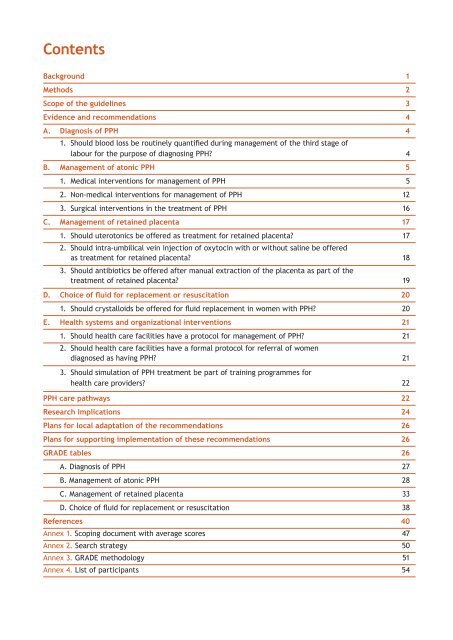WHO guidelines for the management of postpartum haemorrhage ...
WHO guidelines for the management of postpartum haemorrhage ...
WHO guidelines for the management of postpartum haemorrhage ...
You also want an ePaper? Increase the reach of your titles
YUMPU automatically turns print PDFs into web optimized ePapers that Google loves.
Contents<br />
Background 1<br />
Methods 2<br />
Scope <strong>of</strong> <strong>the</strong> <strong>guidelines</strong> 3<br />
Evidence and recommendations 4<br />
A. Diagnosis <strong>of</strong> PPH 4<br />
1. Should blood loss be routinely quantified during <strong>management</strong> <strong>of</strong> <strong>the</strong> third stage <strong>of</strong><br />
labour <strong>for</strong> <strong>the</strong> purpose <strong>of</strong> diagnosing PPH? 4<br />
B. Management <strong>of</strong> atonic PPH 5<br />
1. Medical interventions <strong>for</strong> <strong>management</strong> <strong>of</strong> PPH 5<br />
2. Non-medical interventions <strong>for</strong> <strong>management</strong> <strong>of</strong> PPH 12<br />
3. Surgical interventions in <strong>the</strong> treatment <strong>of</strong> PPH 16<br />
C. Management <strong>of</strong> retained placenta 17<br />
1. Should uterotonics be <strong>of</strong>fered as treatment <strong>for</strong> retained placenta? 17<br />
2. Should intra-umbilical vein injection <strong>of</strong> oxytocin with or without saline be <strong>of</strong>fered<br />
as treatment <strong>for</strong> retained placenta? 18<br />
3. Should antibiotics be <strong>of</strong>fered after manual extraction <strong>of</strong> <strong>the</strong> placenta as part <strong>of</strong> <strong>the</strong><br />
treatment <strong>of</strong> retained placenta? 19<br />
D. Choice <strong>of</strong> fluid <strong>for</strong> replacement or resuscitation 20<br />
1. Should crystalloids be <strong>of</strong>fered <strong>for</strong> fluid replacement in women with PPH? 20<br />
E. Health systems and organizational interventions 21<br />
1. Should health care facilities have a protocol <strong>for</strong> <strong>management</strong> <strong>of</strong> PPH? 21<br />
2. Should health care facilities have a <strong>for</strong>mal protocol <strong>for</strong> referral <strong>of</strong> women<br />
diagnosed as having PPH? 21<br />
3. Should simulation <strong>of</strong> PPH treatment be part <strong>of</strong> training programmes <strong>for</strong><br />
health care providers? 22<br />
PPH care pathways 22<br />
Research Implications 24<br />
Plans <strong>for</strong> local adaptation <strong>of</strong> <strong>the</strong> recommendations 26<br />
Plans <strong>for</strong> supporting implementation <strong>of</strong> <strong>the</strong>se recommendations 26<br />
GRADE tables 26<br />
A. Diagnosis <strong>of</strong> PPH 27<br />
B. Management <strong>of</strong> atonic PPH 28<br />
C. Management <strong>of</strong> retained placenta 33<br />
D. Choice <strong>of</strong> fluid <strong>for</strong> replacement or resuscitation 38<br />
References 40<br />
Annex 1. Scoping document with average scores 47<br />
Annex 2. Search strategy 50<br />
Annex 3. GRADE methodology 51<br />
Annex 4. List <strong>of</strong> participants 54
















